Tetropium castaneum (European spruce longhorn beetle) - Fact Sheet
Identification
Adults are flat, 8 to 18 mm long, with antennae that are half the body length.Footnote 1 Footnote 2 Footnote 3 Adults typically have a black body, brown elytra, and either brown or red antennae and legs.Footnote 1 Footnote 3 The shiny pronotum is rarely punctured. The eyes are separated into two halves and a conspicuous longitudinal groove exists between the antennae on the head.Footnote 1 Footnote 3 Footnote 4 The elytra are uniformly covered with very fine hairs and are densely punctured.Footnote 1 Footnote 3
Host Trees
Picea (main host in Europe), Pinus (main host in Siberia), Abies and Larix.Footnote 1 Footnote 2 Footnote 8 Footnote 3 Footnote 5
Location of Infestation within the Tree
Larvae develop in the inner bark and outer sapwood from the roots upwards on the stem. However the lower bole is usually preferred.Footnote 1 Footnote 6 Footnote 3
Host Condition
Prefers freshly felled trees and stumps and trees weakened by drought, insects, fungi, air pollution, etc. However, healthy trees will also be attacked.Footnote 1 Footnote 2 Footnote 8 Footnote 3 Footnote 5 Footnote 7
Distribution
Europe and Asia (Siberia, North Korea, South Korea, Mongolia, China and Japan).Footnote 2 Footnote 8 Footnote 3
Signs and Symptoms
Eggs are laid singly, or sometimes in clusters of up to 10 eggs, in bark crevices or under bark scales of host trees.Footnote 1 Footnote 8 Footnote 5
Early instar larvae feed on the inner bark and outer sapwood.Footnote 5 Larvae excavate wide, irregular galleries that become densely filled with brown, granular frass.Footnote 1 Footnote 3 Footnote 5 Mature larvae bore horizontally (2 to 5 cm) into the sapwood through narrow elliptical holes.Footnote 1 Then larvae bore parallel to the grain for another 3 to 4 cm and form "L-shaped" galleries. At the end of these galleries, larvae form pupal chambers that are plugged with coarse white frass.Footnote 1 Footnote 2 Footnote 3 Footnote 5 Pupae lie in a vertical position with their heads towards the frass plug.Footnote 3 Footnote 9 Footnote 7 In stumps, pupal cells are usually excavated in exposed roots or at the base.Footnote 5 Adults bore through the bark and emerge through oval exit holes that are 5 mm in diameter.Footnote 1 Footnote 2 Footnote 3
Tetropium castaneum populations can build to levels where living trees are attacked and killed. The boring activity of the larvae can cause structural damage to the wood and may lead to stem breakage during windstorms. Copious resin flow occurs on attacked healthy trees.Footnote 3 The foliage of attacked trees can also fade from green to yellow and finally to reddish-brown.Footnote 8
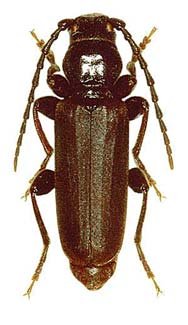
A - Adult T. castaneum (8-18 mm long).4
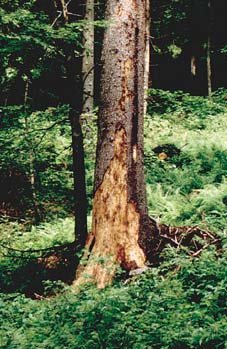
B - Tree killed by T. castaneum. Note sloughing bark.
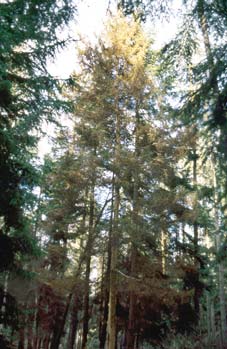
C - Yellowing foliage on attacked tree.
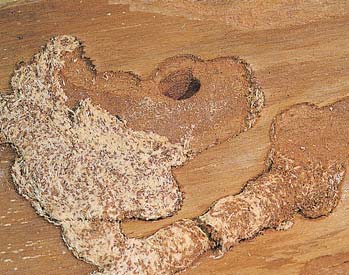
D - T. castaneum gallery filled with brown, granular frass. Note exit hole (5 mm wide).

E - T. castaneum larval galleries and exit holes (5 mm wide).
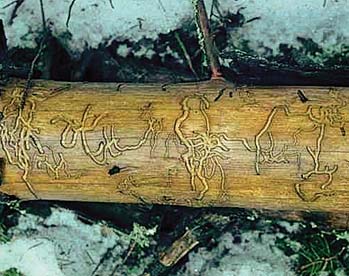
F - Irregularly shaped T. castaneum larval galleries.
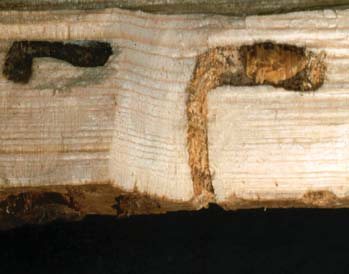
G - Frass plug blocking pupal chamber entrance.
Photo credits
- A Michael Hoskovec, Institute of Organic Chemistry and Biochemistry, Academy of Sciences of the Czech Republic
- B Fabio Stergulc, University of Udin
- C Stanislaw Kinelski, Image 1258308, www.forestryimages.org, July 4, 2004
- D Gyorgy Csoka, Hungary Forest Research Institute, Image 1231096, www.invasive.org, Feb. 4, 2004
- E University of Natural Resources & Applied Life Sciences (BOKU), Austria
- F Norwegian Forest Research Institute, www.skogforsk.no
- G Stanislaw Kinelski, Image 1258317, www.forestryimages.org, July 4, 2004
- Date modified: